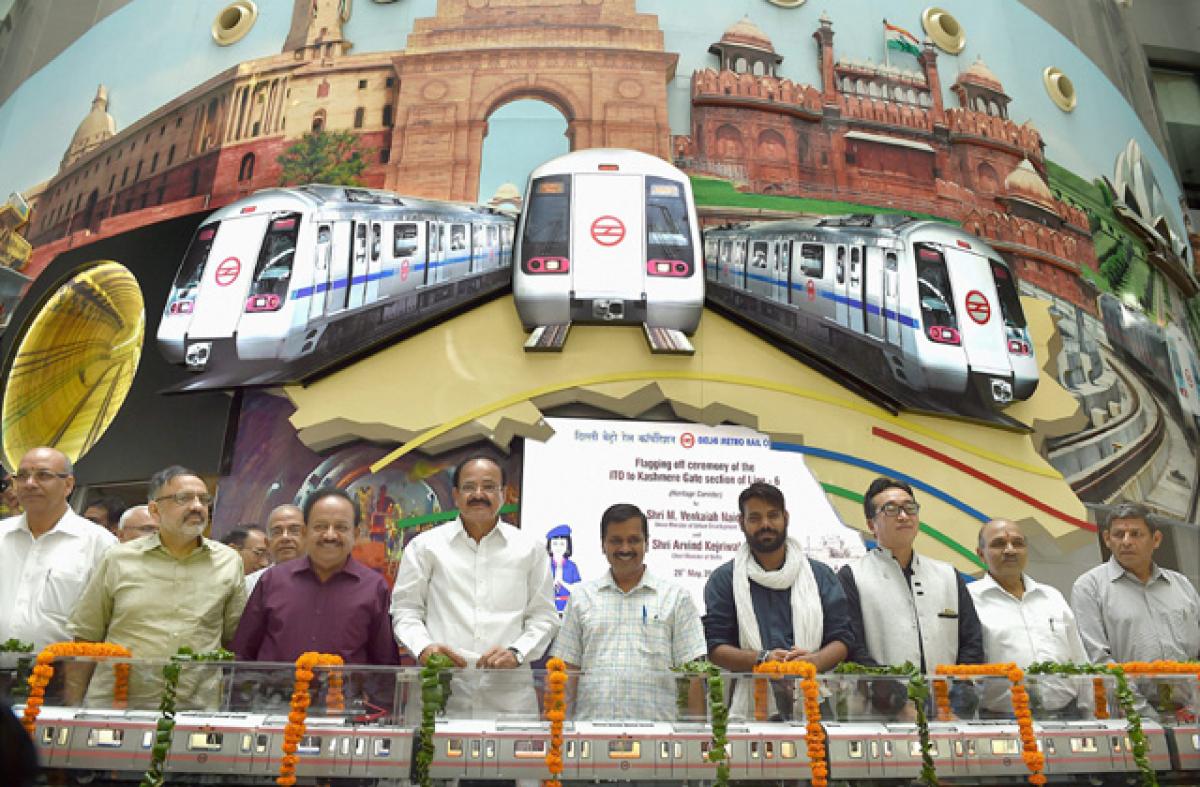Live
- ADB, Tuvalu sign 16.53 million USD grant to improve water, sanitation
- Jharkhand polls: Issues of 'Roti, Beti, Maati' & tribal identity dominated campaign rhetoric
- Kharge seeks President’s intervention to restore normalcy in Manipur
- India aims for equity and balance when negotiating FTAs: Piyush Goyal
- PKL Season 11: ‘Small mistakes in strategy’ led to one-point heartbreak, says Bengaluru Bulls head coach
- Delhi HC directs formation of action plan to deal with bomb threats, other emergencies
- Meeting with Mufti Azhari not to influence votes, don’t support anyone spewing hate: Abu Azmi
- Scott Edwards, Sufyan Mehmood & Gerald Coetzee found guilty of breaching the ICC Code of Conduct
- BGT 2024-25: With family complete, Rohit should now play the Perth Test, says Surinder Khanna
- Coal India wins prestigious Green World Environment Award
Just In

Delhi Metro’s ‘Heritage Line’ between the Central Secretariat and Kashmere Gate, the dream line of the tourists and the locals alike, was thrown open to the commuters here on Sunday.
New Delhi: Delhi Metro’s ‘Heritage Line’ between the Central Secretariat and Kashmere Gate, the dream line of the tourists and the locals alike, was thrown open to the commuters here on Sunday. This line taken up under Phase III was the Delhi Metro Rail Corporation's most challenging task and it connects the Old and New Delhi's.
The line was thrown open to the public at 12 noon on Sunday and the expected traffic numbers are at least one lakh per day. This corridor is called the Heritage Line because it is passing through that part of Delhi which has a rich historical background with lots of heritage monuments that were witness to its splendor in bygone days. Some of the monuments falling alongside its alignment are Jantar Mantar, Ugrasen ki Baoli, Khooni Darwaza, Delhi Gate, Firoze Shah Kotla, Shahi Sunehri Masjid, Lal Quila and Jama Masjid.
It is completely underground work with seven stations: Janpath, Mandi House, ITO, Delhi Gate, Jama Masjid, Lal Quila and Kashmere Gate. This corridor connects the Old Delhi areas like Daryaganj, Delhi Gate and Red Fort with the business hub of Delhi at Janpath. Tunneling close to Heritage sites like Jantar Mantar was extremely challenging according to the DMRC's engineers as the corridor was passing beneath important buildings like the Eastern and Western Courts, Nepal Embassy and American Center.
Anuj Dayal, Executive Director, DMRC, said a piquant situation arose coming to the American Center whose foundation depth could not be ascertained and without knowing which the engineers could not decide the depth of the tunnel which would be passing beneath the building. The structural and other drawings of the building also could not be found.
To measure the depth of the foundation of the American Center, two methods 'Sophisticated Seismic Method' and the 'Parallel Seismic Method'- were used for investigation and determination of the unknown depth of the piles below the ground level of the American Center Building. During investigation only two or three engineers were allowed due to security reasons.
Similarly, at several stretches, gigantic problems cropped up due to sensitive buildings located over ground and hard rock formations coming up underground. Then came the daunting task of evacuation of the Old Daryaganj area houses as a number of dilapidated buildings and structures and DMRC had to put up vertical supports in all structures during the tunneling process. People had to be evacuated in a phased manner from areas like David Street, Gopal Mandir and Kucha Parmanand.
A Total of 2,000 people had to be evacuated. They had been put up in various guest houses situated in the nearby areas and DMRC paid for their lodging and food expenses. The organization also repaired and restored their houses before shifting the residents back. Triple interchange at Kashmere Gate was another stumbling block.
The new station had a major engineering challenge as the new station was infringing on the existing station. Hence, the new station had to be curved at the Platform level and the radius of the curve is 1,000 meters and due to this, the down line is curved, while the up line is straight. Because of the reason, the platform of the new station is also tapered with the width of the platform at the Lal Quila side is 14 meters and it narrows down at the other end to 8.5 meters.
The distance between the tunnel wall of the downline and Pile of the existing metro station is 0.8 meters. The new Station is connected to the existing station at four levels, three at underground levels and one at the elevated concourse of the existing station with the concourse of the new station with an escalator. With this line now being thrown open to public, the best of Delhi becomes easily accessible to the tourists and those not used to the extreme climes of the National Capital, need not worry about the tedious journeys. Just hop on the Heritage Line metro!

© 2024 Hyderabad Media House Limited/The Hans India. All rights reserved. Powered by hocalwire.com







